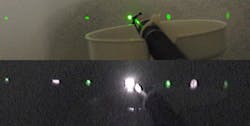College Park, MD--Green laser pointers have become a popular consumer item, but stories have circulated on the Web about the potential hazards of inexpensive models. Now, a team led by physicist Charles Clark at the National Institute of Standards and Technology (NIST) puts some numbers to the problem. In one case, the group found that a green laser pointer emitted almost twice its rated power level of light—but at invisible and potentially dangerous IR wavelengths rather than green. A new NIST technical note describes the nature of the problem as well as a home test using an inexpensive webcam that can detect excess IR light from green lasers.1
Late last year, the research team purchased three low-cost green laser pointers advertised to have a power output of 10 mW. Measurements showed that one unit emitted dim green light but delivered IR levels of nearly 20 mW—powerful enough to cause retinal damage to an individual before he or she is aware of the invisible light. NIST's Jemellie Galang and her colleagues repeated the tests with several other laser pointers and found similarly intense IR emissions in some but not all units.
The above figure shows light from a green laser diffracted into several spots, taken with an ordinary camera having an IR-blocking filter. The green laser pointer is visible in the foreground. The same setup is photographed with a webcam with no IR-blocking filter (bottom), revealing intense diffracted spots of light at 808 nm, a wavelength invisible to the eye.
Cheap, dangerous pointers
The problem stems from inadequate procedures in manufacturing quality assurance, according to the research team. Inside a green laser pointer, an 808-nm-emitting laser diode pumps a crystal of neodymium-doped yttrium orthovanadate (Nd:YVO4), causing the crystal to lase at 1064 nm. The output is frequency-doubled to 532 nm (green) in a crystal of potassium titanyl phosphate (KTP).
However, if the KTP crystal is misaligned, little of the 1064 nm light is converted into green light, and most of it comes out as IR. Excess IR leakage can also occur if the dichroic (in this case, IR-reflecting and green-transmitting) coatings at both ends of the crystal are less than optimum.
The NIST team says this problem could be solved by incorporating an inexpensive IR filter at the end of the laser, which could reduce infrared emissions by a factor of 100 to 1000 (depending on quality and cost). Although these filters exist in modern digital cameras and more expensive green laser pointers, they often are left out of the inexpensive models.
Be careful around windows
The team demonstrates a home test that laser hobbyists could conduct to detect excessive IR leakage by using a common digital or cell-phone camera, a compact disc, a webcam, and a TV remote control. Regardless, they say owners of the devices should never point the lasers at the eyes or aim them at surfaces such as windows, which can reflect IR light back to the user—a particularly subtle hazard because many modern energy-saving windows have coatings designed specifically to reflect IR.
The researchers are all members of the Joint Quantum Institute, a collaboration of NIST and the University of Maryland. Co-author Edward W. Hagley is also at Acadia Optronics (Rockville, MD).
REFERENCE
1. J. Galang et al., NIST Technical Note (TN 1668), A Green Laser Pointer Hazard (July 2010), available on-line at www.nist.gov/manuscript-publication-search.cfm?pub_id=906138

John Wallace | Senior Technical Editor (1998-2022)
John Wallace was with Laser Focus World for nearly 25 years, retiring in late June 2022. He obtained a bachelor's degree in mechanical engineering and physics at Rutgers University and a master's in optical engineering at the University of Rochester. Before becoming an editor, John worked as an engineer at RCA, Exxon, Eastman Kodak, and GCA Corporation.
